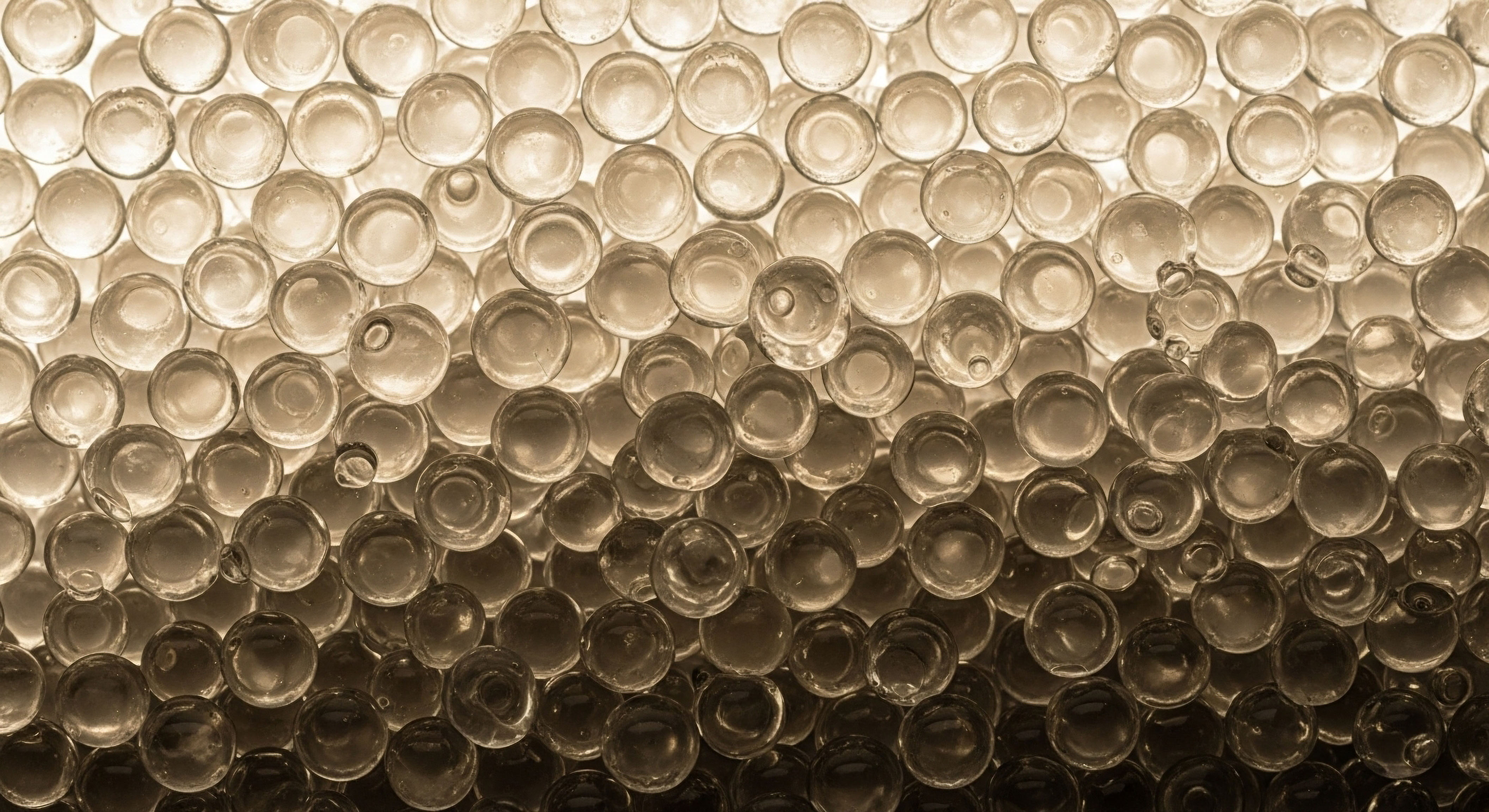

Fundamentals
You feel it in the final repetitions of a lift, the last mile of a run, or the pervasive slowness that clouds your morning. It is a subtle yet persistent signal from your body that its internal communication system is no longer operating with the seamless efficiency it once did.
This experience, a feeling of diminished capacity despite consistent effort, is a common starting point for active individuals on a journey to understand their own biology. Your body’s endocrine network, a sophisticated web of glands and hormones, dictates everything from energy utilization and muscle repair to mood and cognitive focus. When this system begins to function sub-optimally, the effects are felt profoundly in every aspect of an active life.
Understanding the clinical considerations for hormonal optimization begins with acknowledging these subjective experiences and mapping them to objective biological processes. The fatigue that training no longer resolves, the stubborn accumulation of body fat around the midsection, the mental fog that dulls your edge ∞ these are data points.
They are valuable pieces of information that, when paired with clinical assessment, illuminate the status of your internal hormonal environment. The goal of optimization is to recalibrate this environment, restoring the robust signaling pathways that support vitality and peak function. This process involves a deep respect for the body’s intricate feedback loops, particularly the Hypothalamic-Pituitary-Gonadal (HPG) axis, which acts as the central command for sex hormone production.

The Language of Hormones
Hormones are the body’s primary chemical messengers. They are produced by endocrine glands, released into the bloodstream, and travel to target cells to exert specific effects. Think of this as a highly precise postal service.
A gland like the pituitary sends a specific message (a hormone like Luteinizing Hormone, or LH) to a specific address (the testes or ovaries), with a specific instruction (produce testosterone or estrogen). For the active individual, the most relevant messengers are often testosterone, estrogen, progesterone, and growth hormone. Their balance, and the body’s ability to produce and respond to them, is fundamental to maintaining muscle mass, managing body composition, ensuring effective recovery, and sustaining metabolic health.

Why Does Balance Matter for the Active Body?
An active body places immense demands on its systems. Intense physical training is a stressor, one that requires a powerful adaptive response coordinated by the endocrine system. Hormonal imbalances can disrupt this adaptive process. For instance, chronically low testosterone in a male athlete can directly impair protein synthesis, slowing muscle repair and growth.
In a female athlete, disruptions in the estrogen-progesterone balance during perimenopause can affect bone density, mood, and energy regulation, making training and recovery more challenging. Growth hormone and its downstream mediator, IGF-1, are likewise integral to tissue repair. When their signaling is blunted, the body’s ability to heal from strenuous exercise is compromised.
The clinical approach, therefore, views the active individual’s body as a high-performance system that requires precise tuning. The symptoms of imbalance are the first indication that this system requires a diagnostic evaluation.
The journey toward hormonal optimization begins by translating the subjective feelings of diminished performance into an objective understanding of your body’s intricate endocrine system.
This foundational perspective allows for a more targeted and effective strategy. It shifts the focus from simply chasing numbers on a lab report to restoring a state of physiological equilibrium where the body can once again adapt and respond effectively to the demands of an active life. The clinical process is one of measurement, interpretation, and precise intervention, all guided by the unique biological context of the individual.


Intermediate
Moving from the foundational understanding of hormonal balance to its clinical application requires a detailed examination of specific therapeutic protocols. For active individuals, these protocols are designed to restore hormonal parameters to a range that supports physiological function, recovery, and overall well-being.
The interventions are precise, data-driven, and tailored to the unique endocrine profile of each person, whether male or female. The core principle is to use the minimum effective dose of a bioidentical hormone or signaling peptide to achieve a desired clinical outcome while actively managing potential side effects. This is accomplished through a sophisticated understanding of the body’s feedback loops and the use of ancillary medications to maintain systemic harmony.

Protocols for Male Hormonal Optimization
For middle-aged and older men experiencing the symptoms of andropause or clinically low testosterone (hypogonadism), Testosterone Replacement Therapy (TRT) is a primary clinical strategy. The goal is to restore serum testosterone levels to a healthy physiological range, thereby improving libido, energy levels, cognitive function, and body composition. A standard, effective protocol involves a multi-faceted approach.
- Testosterone Cypionate ∞ This is a bioidentical form of testosterone delivered via weekly intramuscular or subcutaneous injections. A typical starting dose is administered to normalize testosterone levels, with adjustments made based on follow-up lab work and symptom response.
- Gonadorelin ∞ Exogenous testosterone administration suppresses the body’s natural production by downregulating the HPG axis. Gonadorelin, a GnRH analog, is used to send a direct signal to the pituitary, stimulating the release of LH and FSH. This helps maintain testicular volume and preserve some endogenous testosterone production and fertility. It is typically injected subcutaneously twice per week.
- Anastrozole ∞ Testosterone can be converted into estradiol via the aromatase enzyme. In some men, TRT can lead to elevated estrogen levels, which may cause side effects like water retention or gynecomastia. Anastrozole is an aromatase inhibitor, an oral tablet taken to block this conversion and keep estradiol within an optimal range.
- Enclomiphene ∞ In some protocols, Enclomiphene may be used as an alternative or adjunct therapy. As a selective estrogen receptor modulator (SERM), it blocks estrogen receptors at the pituitary, which in turn increases LH and FSH output, stimulating the testes to produce more of their own testosterone.

Protocols for Female Hormonal Optimization
Hormonal optimization in women presents a different set of considerations, often centered on the fluctuations of perimenopause and the deficiencies of post-menopause. The clinical objective is to alleviate symptoms like hot flashes, mood swings, irregular cycles, and low libido while supporting bone density and metabolic health.
Protocols are highly individualized, based on menopausal status and specific symptoms.
| Therapeutic Agent | Typical Application and Protocol | Clinical Rationale |
|---|---|---|
| Testosterone Cypionate | Low-dose weekly subcutaneous injections (e.g. 10 ∞ 20 units). | Addresses symptoms of low libido, fatigue, and mental fog. Provides benefits for muscle tone and overall vitality. |
| Progesterone | Oral or topical administration, prescribed based on menopausal status (cyclic for perimenopausal, continuous for postmenopausal). | Balances the effects of estrogen, supports sleep and mood, and is essential for protecting the uterine lining in women who still have a uterus and are on estrogen therapy. |
| Pellet Therapy | Long-acting testosterone pellets implanted subcutaneously. Anastrozole may be co-administered if needed. | Offers a sustained, steady-state release of testosterone over several months, providing a convenient alternative to weekly injections for some individuals. |

What Are the Protocols for Restoring Fertility Post-Therapy?
For men who have been on TRT and wish to discontinue it to restore fertility, a specific post-cycle therapy (PCT) protocol is required. Because TRT suppresses the natural hormonal axis, simply stopping treatment can lead to a prolonged period of hypogonadism. The goal of a PCT is to rapidly restart the HPG axis.
Effective hormonal protocols are dynamic systems, requiring ongoing monitoring and adjustment to align with the body’s response and the individual’s evolving health goals.
A typical fertility-stimulating protocol involves a combination of medications designed to stimulate the pituitary and block estrogen’s negative feedback.
- Gonadorelin ∞ Used to directly stimulate the pituitary gland to produce LH and FSH.
- Clomiphene (Clomid) / Tamoxifen (Nolvadex) ∞ These SERMs block estrogen receptors in the hypothalamus and pituitary. This action tricks the brain into perceiving low estrogen levels, prompting it to ramp up the production of GnRH, and subsequently LH and FSH, which signal the testes to produce testosterone and sperm.
- Anastrozole ∞ May be used to control estrogen levels as the HPG axis restarts and testosterone production increases.
These intermediate protocols demonstrate a clinical approach that is both proactive and responsive. It uses a deep understanding of physiology to restore function, always balancing therapeutic benefit with careful management of the body’s interconnected systems.


Academic
An academic exploration of hormonal optimization in active individuals requires a systems-biology perspective, moving beyond symptom management to analyze the intricate biochemical and physiological mechanisms at play. The central organizing principle of this system is the Hypothalamic-Pituitary-Gonadal (HPG) axis, a complex and elegant feedback loop that governs reproductive function and steroidogenesis.
The introduction of exogenous hormones or signaling peptides represents a significant perturbation to this finely tuned system. The clinical and physiological consequences of this perturbation, along with the strategies to mitigate them, form the core of a sophisticated academic inquiry.

The HPG Axis under Exogenous Influence
When an active individual begins a protocol of Testosterone Replacement Therapy (TRT), the therapeutic goal is to restore serum testosterone to youthful, physiological levels. From a systems perspective, however, this introduces a powerful negative feedback signal to the hypothalamus and pituitary gland. The hypothalamus reduces its pulsatile release of Gonadotropin-Releasing Hormone (GnRH).
Consequently, the anterior pituitary gland drastically curtails its secretion of Luteinizing Hormone (LH) and Follicle-Stimulating Hormone (FSH). This downregulation has two primary consequences ∞ the cessation of endogenous testosterone production by the testicular Leydig cells (stimulated by LH) and the impairment of spermatogenesis within the seminiferous tubules (supported by FSH). This state of secondary hypogonadism is an expected and managed outcome of TRT.
The clinical use of agents like Gonadorelin represents a direct intervention to counteract this shutdown. By acting as a GnRH agonist, Gonadorelin bypasses the suppressed hypothalamus and directly stimulates the pituitary gonadotrophs, inducing LH and FSH release. This maintains some level of testicular function and volume, a consideration that is both physiological and psychological for many individuals.
The academic view of this intervention is one of maintaining the downstream machinery of the HPG axis in a state of readiness, preventing the more severe testicular atrophy that would otherwise occur with long-term TRT.

Peptide Therapy a New Frontier in GHRH/GHS Signaling
Growth Hormone Peptide Therapies operate on a different but parallel axis ∞ the Growth Hormone-Releasing Hormone (GHRH) / Growth Hormone Secretagogue (GHS) / Somatostatin axis. Peptides like Sermorelin are GHRH analogs, meaning they mimic the body’s natural GHRH to stimulate the pituitary somatotrophs to release Growth Hormone (GH). Others, like Ipamorelin, are GHSs, meaning they mimic the hormone ghrelin and bind to the GHS-R1a receptor, also triggering GH release.
The combination of a GHRH analog (like CJC-1295) with a GHS (like Ipamorelin) is a subject of great interest. Research suggests a synergistic effect. CJC-1295 provides a sustained elevation of the GH baseline by stimulating the GHRH receptor, while Ipamorelin induces a sharp, pulsatile release by activating the ghrelin receptor.
This dual-mechanism approach is theorized to produce a more robust and biomimetic GH release profile than either agent alone, amplifying the downstream effects on IGF-1 production, lipolysis, and tissue repair. From a clinical research perspective, the key advantage is achieving a significant therapeutic effect while preserving the natural pulsatile nature of GH secretion, which is critical for proper receptor function and avoiding the desensitization seen with continuous, non-pulsatile GH administration.
The sophisticated clinical management of hormonal optimization hinges on modulating key endocrine feedback loops to achieve therapeutic benefits while preserving long-term systemic integrity.
| Peptide Class | Example(s) | Primary Mechanism of Action | Key Clinical Characteristic |
|---|---|---|---|
| GHRH Analogs | Sermorelin, CJC-1295 | Binds to GHRH receptors on the pituitary gland, stimulating the synthesis and secretion of Growth Hormone. | Increases the overall amount and pulse amplitude of GH release, working within the body’s natural regulatory rhythm. |
| GHS (Ghrelin Mimetics) | Ipamorelin, Hexarelin | Binds to GHS-R1a (ghrelin receptors) on the pituitary gland, inducing a strong, pulsatile release of Growth Hormone. | Provides a potent, selective stimulus for GH release, often with minimal impact on other hormones like cortisol. |
| GHS (Ibutamoren) | MK-677 | An orally active GHS that mimics ghrelin, stimulating GH and IGF-1 release. | Offers the convenience of oral administration but may also increase cortisol and prolactin. |

How Do Regulatory Frameworks Influence Clinical Application?
A significant academic and clinical consideration is the regulatory status of these compounds. While testosterone and progesterone are FDA-approved for treating specific medical conditions, many peptides exist in a gray area of “research chemicals.” This impacts their availability, quality control, and the formal clinical data supporting their use.
An active individual seeking optimization must navigate this landscape, underscoring the importance of sourcing these therapies through a qualified clinical provider who can ensure pharmaceutical-grade purity and appropriate, evidence-informed dosing protocols.
The off-label use of SERMs like Clomiphene and Tamoxifen for PCT is another example, where established clinical tools are repurposed based on a deep physiological rationale to manage the consequences of other hormonal interventions. This practice is common in endocrinology and highlights the need for a clinician’s expertise in applying biochemical knowledge to complex, real-world scenarios.

References
- Te, Peter, and Jason M. Kring. “Testosterone replacement therapy ∞ clinical considerations.” Taylor & Francis Online, 2021.
- Stuenkel, Cynthia A. et al. “Treatment of Symptoms of the Menopause ∞ An Endocrine Society Clinical Practice Guideline.” The Journal of Clinical Endocrinology & Metabolism, vol. 100, no. 11, 2015, pp. 3975 ∞ 4011.
- Teichmann, J. et al. “Prolonged stimulation of growth hormone (GH) and insulin-like growth factor I secretion by CJC-1295, a long-acting analog of GH-releasing hormone, in healthy adults.” The Journal of Clinical Endocrinology & Metabolism, vol. 91, no. 3, 2006, pp. 799-805.
- Pereira, R. F. et al. “Anabolic steroid-induced hypogonadism ∞ a treatable and reversible condition.” Journal of the Endocrine Society, vol. 3, no. Supplement_1, 2019.
- Bonnecaze, A. K. et al. “The effects of clomiphene citrate and anastrozole on the recovery of the hypothalamic-pituitary-gonadal axis in men with hypogonadism.” The World Journal of Men’s Health, vol. 39, no. 3, 2021, pp. 525-532.
- Raun, K. et al. “Ipamorelin, the first selective growth hormone secretagogue.” European Journal of Endocrinology, vol. 139, no. 5, 1998, pp. 552-561.
- de Ronde, W. and H. M. Behre. “The use of selective estrogen receptor modulators for male contraception and treatment of male infertility.” Andrology, vol. 4, no. 4, 2016, pp. 596-601.
- Bhasin, S. et al. “Testosterone replacement increases fat-free mass and muscle size in hypogonadal men.” The Journal of Clinical Endocrinology & Metabolism, vol. 82, no. 2, 1997, pp. 407-413.

Reflection
The information presented here provides a map of the biological terrain you inhabit. It details the pathways, the messengers, and the clinical strategies available for navigating it. Your own body, however, holds the compass. The lived experience of your energy, your strength, and your mental clarity is the ultimate guide.
This knowledge is a tool, empowering you to ask more precise questions and to seek a partnership with a clinician who speaks the language of both symptoms and systems. The path forward is one of self-awareness and proactive collaboration, using objective data to inform a deeply personal process of reclaiming your physiological potential.

Glossary

hormonal optimization

growth hormone

testosterone replacement therapy

gonadorelin

hpg axis

anastrozole

post-cycle therapy

pituitary gland




